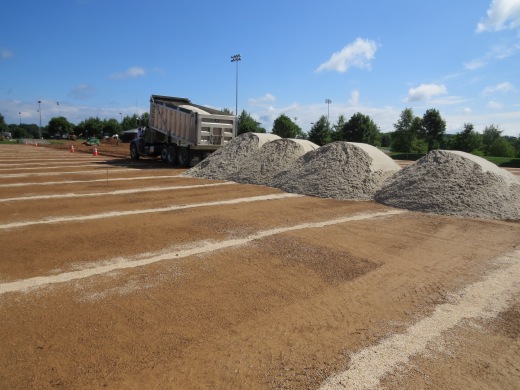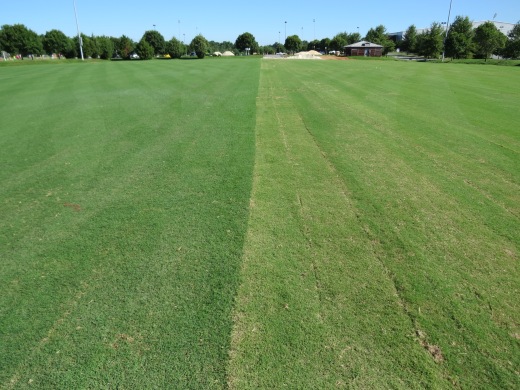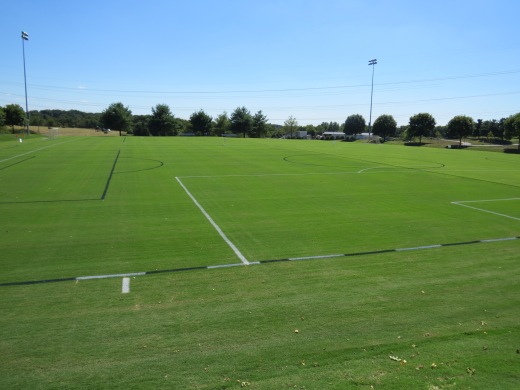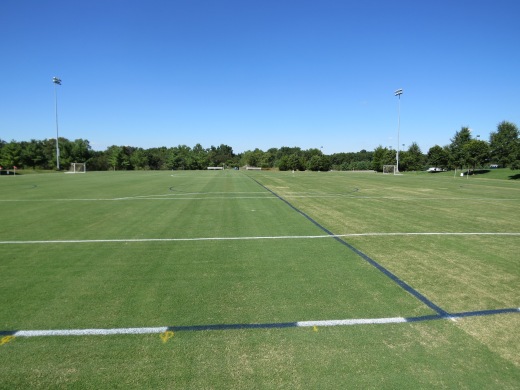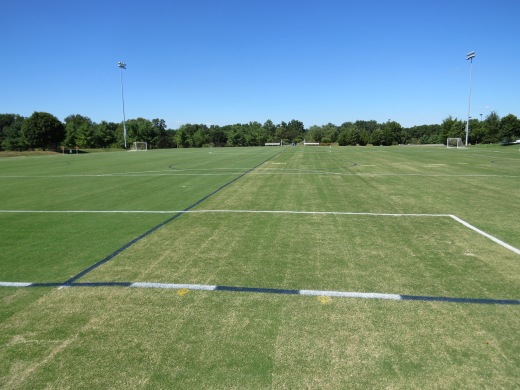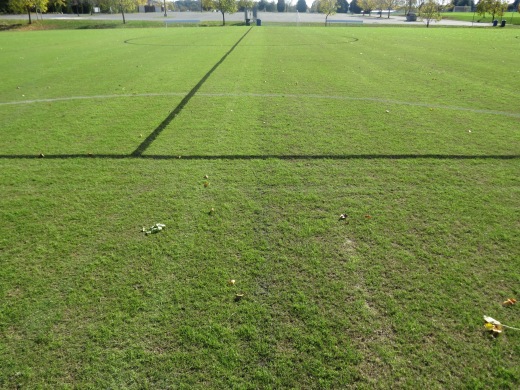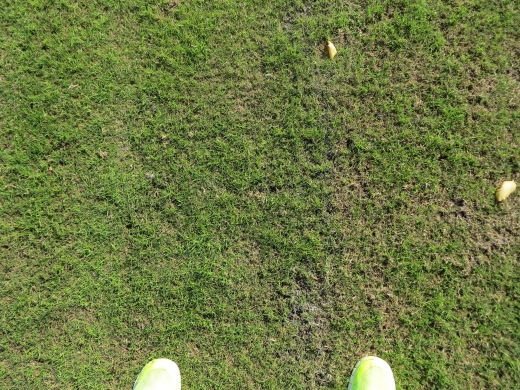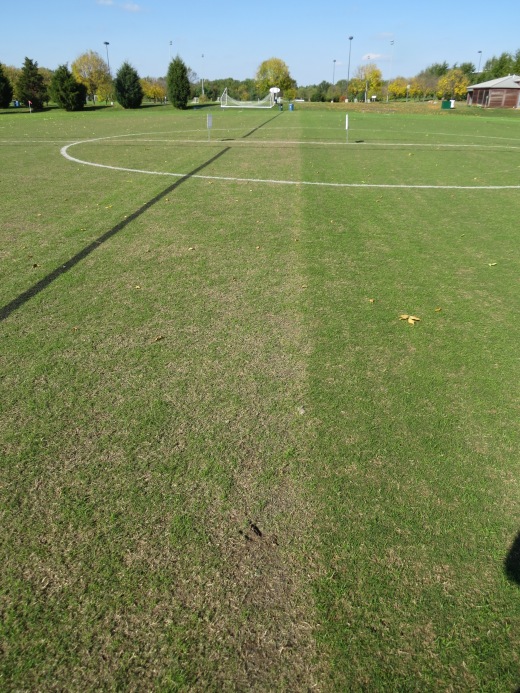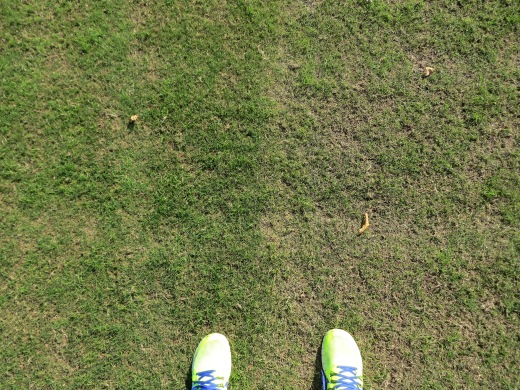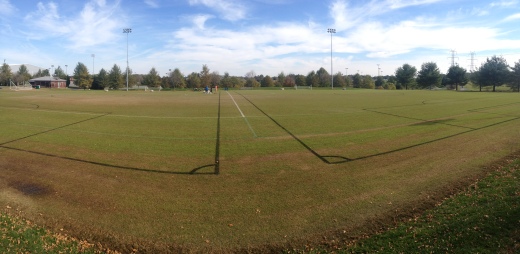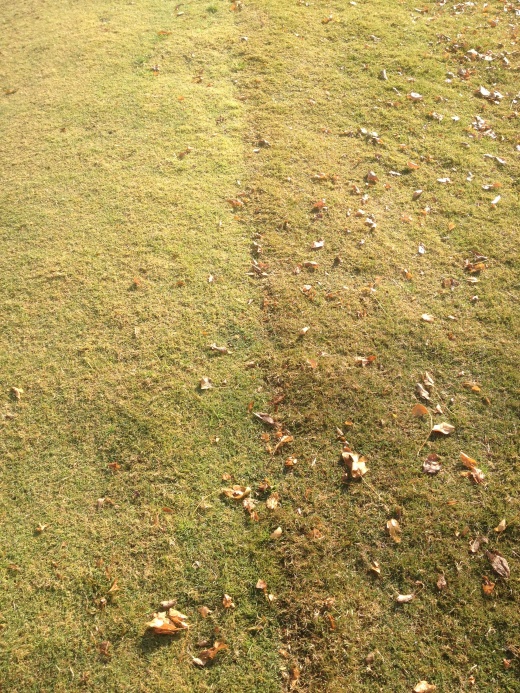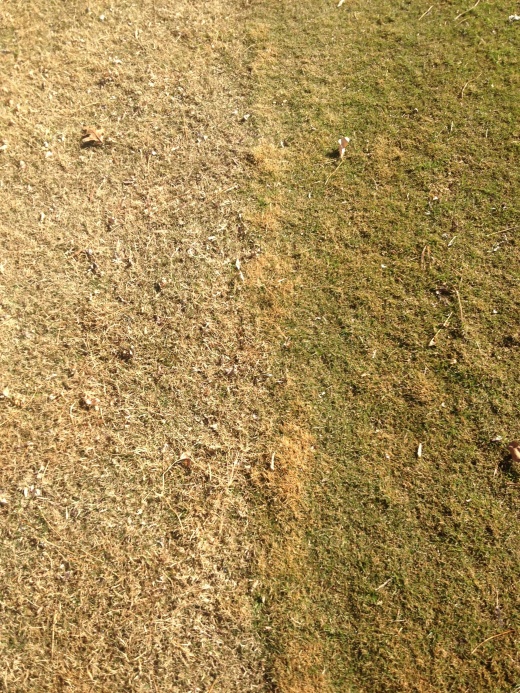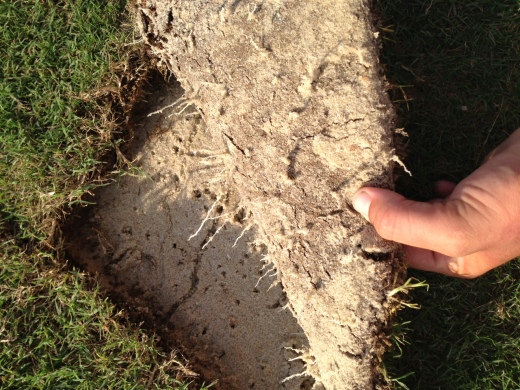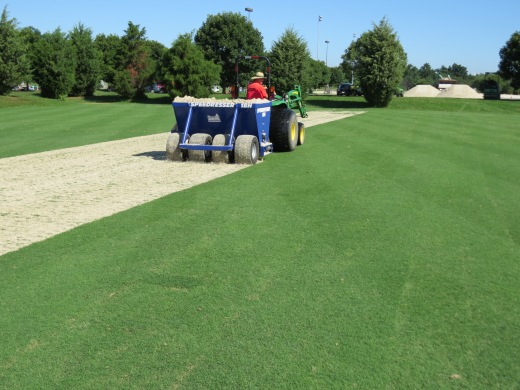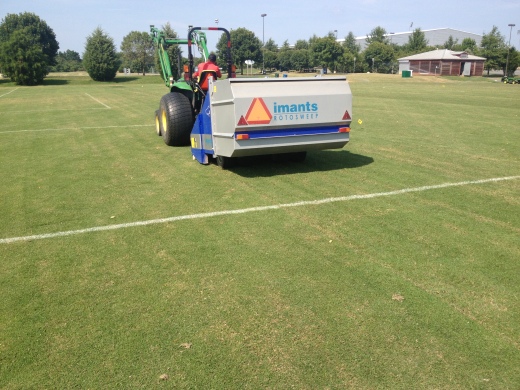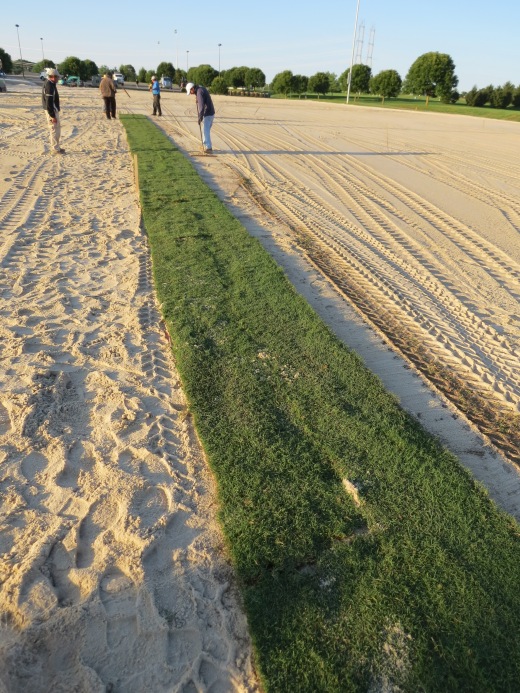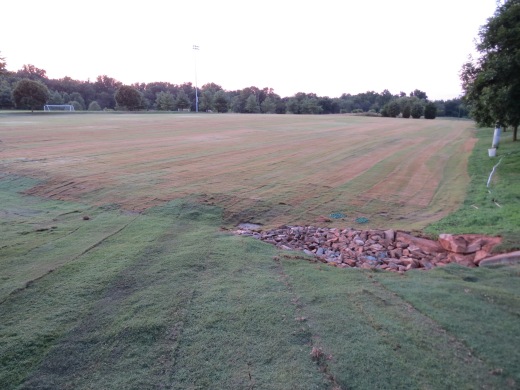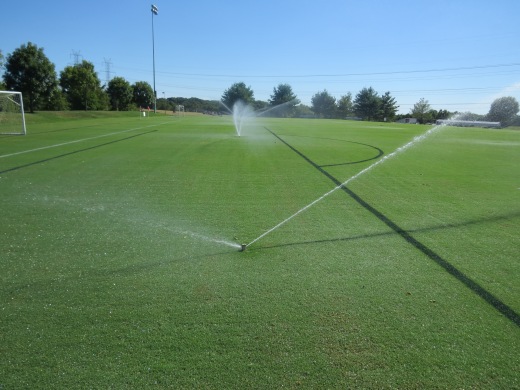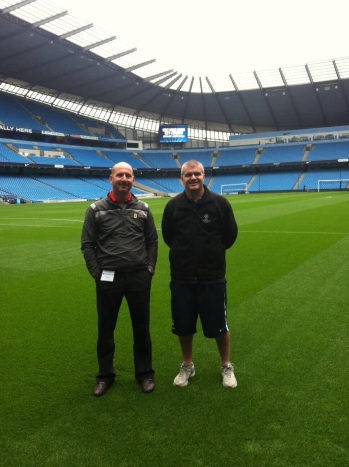Welcome to 2014! SoccerPlex Grounds & Envrionmental Management is updating you on the fall results of the Bermuda Performance Test taking place on Fields 14 & 17. Announcement: Bermudagrass Performance Test gives a few more details.
SoccerPlex Fields 14 & 17 were re-constructed from their native soil/ heavy clay base into sand soil rootzones in August, 2013. The sand rootzone allows the fields to never close during rain and to sustain more use from matches, trainings, events, etc. Late summer heat during the field installation and heavy traffic being put on the fields only 6 days after installation made bermudagrass the grass of choice for the fields.
The challenging question to answer was which variety of bermudagrass fit the challenge of high traffic fields to be maintained at a professional quality? Four varieties of bermudagrass are viable for heavy traffic and cold winters in the Washington, DC region; Patriot, Riviera, Latitude 36, and Northbridge. Because was no solid head to head data that SocccerPlex GEM management could find established which was best for the situation… we instead instituted our own test.
Test:
The two fields had two grass installed on each half, with the varieties being split directly down the middle. Splitting down the middle was important, as the end of the field closest to the parking lot always gets the most use.
The fields broke down to:
Field 14: Northbridge on 1/2, Patriot on 1/2
Field 17: Latitude 36 on 1/2, Riviera on 1/2
Grow-In/ Establishment of Each Variety
The sod quality of the varieties was completely different. But the inconsistency added an additional dimension to the observation and test, especially during grow-in and establishment:
Riviera: Riviera bermudagrass is a seeded variety. Being that seedlings may not have the established stolon and rhizome network of vegetative varieties, there was an initial concern about what the sod quality of Riviera. That concern proved wrong. The Riviera sod quality was nearly perfect and establishment was immediate. Not a single piece of sod came apart and 4″ roots were into the sand within 5 days. The Riviera sod was some of the best ever seen at SoccerPlex. From an establishment perspective, Riviera was fantastic.
Latitude 36: Latitude 36 is a new variety only available in the last 18-24 months for use. Due to the sod being a very young age, the quality was poor. But instead of the quality being a detriment, it actually turned into an important piece to understand Latitude 36’s ability to grow and recover. Still within 7 days, the Latitude was rooted. Within 14 days any thin/ broken sod pieces were re-estblished. And within 21 days, there no longer could be seen any quality issues. The sod quality was weak, but from an establishment perspective, Latitude 36 was fantastic even still.
Patriot: Patriot bermudagrass is well known at SoccerPlex. With 7 total Patriot bermudagrass fields in the park, SoccerPlex GEM is a huge fan of Patriot bermudagrass for high traffic. It is a grass always up for any challenge. The sod quality of the Patriot was good and the establishment of the Patriot was even better. Being a known quantity, the Patriot sod quality and grow-in performance was exactly as expected. Excellent all around.
Northbridge: Northbridge bermudagrass was the least known to SoccerPlex GEM of the 4 bermudagrasses used. But Northbridge also had the most “upside” to all the bermuda varieties being that is was somewhat unknown. The sod quality of the Northbridge provided a challenge though. Because of heavy rains and a lack of time for mowing in the field, the Northbridge had been scalped down with little remaining green leaf tissue to create aggressive growth quickly. Similar to the Latitude 36, this could have been a negative for the grass. But again, the initial set back provided perspective to the possibilities of Northbridge. The sod rolls still head together completely and rooted within 7 days. 28 days later, the initial issues with Northbridge were unknown. Sod quality was not great. Establishment of Northbridge was fantastic.
Fall Usage
Both fields went into play immediately. Starting 6 full days after final installation, the fields sustained traffic through Thanksgiving. In that time period, Field 14 hosted 93 matches/ trainings and Field 17 hosted 105 matches/ trainings. The heavy traffic provided quite an interesting perspective of the durability of the different varieties.
Wear Tolerance
All four varieties showed equal and strong wear tolerance during the 1st 7 weeks of use. Then a weekend tournament on Oct. 12 & 13 changed everything. In mid-September the fields were overseeded with 6 lbs of Barenbrug SOS ryegrass, making a nice mix of bermudagrass and rye grass. Going into the tournament, there was no reason visible difference from any of the varieties.
During the tournament weekend, 16 matches were play on each field during a consistent rainfall that totally nearly 6″. All varieties performed very well. But the Latitude 36 and the Northbridge set themselves apart in shear strength and over all durability. The pictures are very obvious:
WHY DID WE SEE SUCH A DRAMATIC DIFFERENCE???
Immediately the question to answer was WHY is the difference so dramatic, so quickly?? During the weekend tournament, SoccerPlex GEM had the privilege to have Mr. Roberto Gurgel and Ms. Erin Boyd Wilder of Sod Solutions in to observe the Latitude 36 and Northbridge. Mr. Alexandre Santos of Green Leaf in Brazil was also visiting with them. With such a group of experienced and bright turfgrass minds present, our conclusion was:
Over all density
Latitude 36 and Northbridge are both very fine leafed. The stolons and rhizomes are very small with short internodes. With those 2 factors, the Latitude 36 and Northbridge “weave together” and create a more dense and tight surface that is harder for players and their cleats to break through.
The wet conditions during the tournament left the sod layer wet, causing the Patriot and Riviera to thin out more because they weren’t “weaved together” as tightly as the Latitude 36 and the Northbridge.
All varieties performed well still under such traffic demand and in terrible weather. But the Latitude 36 and Northbridge for the 1st time illustrated a visible difference during the tournament.
Wear Tolerance Cont:
Another example of the difference in wear tolerance came on Field 17. But even more interesting, there became an example between the far end of the Riviera v the closest end to the parking lot. SoccerPlex GEM works closely with the scheduling specialists for SoccerPlex fields to “balance” play on the fields. However the closest end of a field to parking lots always gets the most use. Field 17 gave a black and white example of how important balance on a field is:
Note in the picture how much more worn the left small sided field is compared to the right side. Both fields are Riviera w/ SOS ryegrass overseeded into it.
Late Season Color
Latitude 36 and Northbridge again set themselves apart in holding color late into the season. All four varieties held their color well into the 1st week of November, even with consistent frost and low temperatures in the 20’s and 30’s. On Nov. 15, the average low temperature for November at SoccerPlex was 35.9 degrees F. The lowest temperature recorded had been 23. Yet sustained green was still in the Latitude 36 and Northbridge. Patriot also was holding some color, about 1/2 of the amount of the Northbridge (that color was consistent on all 7 other Patriot bermudagrass fields at SoccerPlex)
Summary:
To use one word to summarize the initial results of the SoccerPlex Bermudagrass Performance Test: WOW! The possibility of ALL these genetics is so exciting!
Riviera: Performed consistently. Sod quality was fantastic. Establishment was fast. Wear tolerance was good. Late season growth and color was good. Because it comes from seed, spring and summer 2014 will allow the Riviera to mature and show us more characteristics.
Patriot: Performed consistently and strong. Sod quality was great. Establishment was fast. Wear tolerance was excellent. Late season growth and color were excellent. We got exactly what we expected from the Patriot, showing why it is used on 7 other fields at SoccerPlex able to host over 1000 hours of play per season.
Latitude 36: Performed intriguingly well. Sod quality was poor do to immaturity. But the plant population was still strong and lush. Establishment was still fast. Wear tolerance was excellent, even amazing with how it set itself apart in October. Late season growth and color were amazing. The possibilities of Latitude 36 are endless if spring green up and aggressive growth happen early after such heavy traffic in the fall.
Northbridge: Perform intriguingly as well. Sod quality was good in the aspect it held together nicely, but the scalped plants hurt badly. Yet it was able to completely recover and catch up to the other varieties. Wear tolerance was excellent, even amazing with how it set itself apart from Patriot, a fantastic grass. Late season growth and color were amazing. The possibilities of Northbridge are endless if spring green up and aggressive growth happen early after such heavy traffic in the fall.
Pick a winner (so far)?
Nope! Can’t be done. Spring green up and recovery from late fall heavy traffic will make or break each of the varieties in this trial. Stay tuned… the possibilities really are exciting!!
